I am working with SAP Timesheet data, so there are millions of rows. What I am trying to do is select the data from the SAP table and insert it into a table on MS SQL Server.
So I want to insert the original record, then if an update to the original record happens, which is in the form of a new SAP record with a refcounter, I want to find the original record in my table and update it, keeping the original counter value.
So I have done this successfully with a cursor (I know not the best), but with millions of records, I am wondering if there is a faster way, because I am on day 4 of my cursor running. Is there a better way then what I have below:
BEGIN
CREATE TABLE CATSDB
(
[COUNTER] nvarchar(12),
REFCOUNTER nvarchar(12),
PERNR nvarchar(8),
WORKDATE nvarchar(8),
CATSHOURS decimal(7, 3),
APDAT nvarchar(8),
LAETM nvarchar(6),
CATS_STATUS nvarchar(2),
APPR_STATUS nvarchar(2)
)
INSERT INTO CATSDB
(
[COUNTER],REFCOUNTER,PERNR,WORKDATE,CATSHOURS,APDAT,LAETM,CATS_STATUS,APPR_STATUS
)
VALUES
('000421692670',NULL,'00000071','20190114','6.00','20190204','174541','30','30'),
('000421692671',NULL,'00000071','20190114','3.00','20190204','174541','30','30'),
('000421692672',NULL,'00000071','20190115','6.00','00000000','000000','60','20'),
('000421692673',NULL,'00000071','20190115','3.00','00000000','000000','60','20'),
('000421692712','000421692672','00000071','20190115','0.00','20190115','111007','30','30'),
('000421692713','000421692673','00000071','20190115','0.00','20190115','111007','30','30'),
('000429718015',NULL,'00000072','20190313','7.00','00000000','000000','60','20'),
('000429718016',NULL,'00000072','20190313','1.50','20190315','164659','30','30'),
('000429718017',NULL,'00000072','20190313','1.00','20190315','164659','30','30'),
('000430154143',NULL,'00000072','20190313','2.00','00000000','000000','60','20'),
('000430154142','000429718015','00000072','20190313','5.00','00000000','000000','60','20'),
('000430154928','000430154142','00000072','20190313','4.50','20190315','164659','30','30'),
('000430154929','000430154143','00000072','20190313','2.50','20190315','164659','30','30'),
('000429774620',NULL,'00000152','20190314','1.00','00000000','000000','60','20'),
('000429774619',NULL,'00000152','20190314','1.00','00000000','000000','60','20'),
('000429802106','000429774620','00000152','20190314','2.00','00000000','000000','60','20'),
('000429802105','000429774619','00000152','20190314','3.00','00000000','000000','60','20'),
('000429840242','000429802106','00000152','20190314','4.00','20190315','143857','30','30'),
('000429840241','000429802105','00000152','20190314','5.00','20190315','143857','30','30')
CREATE TABLE [TBL_COUNTER]
(
[COUNTER] [varchar](12) NOT NULL,
[REFCOUNTER] [varchar](12) NULL
)
CREATE TABLE TEMP
(
[COUNTER] [nvarchar](12) NOT NULL,
[REFCOUNTER] [nvarchar](12) NULL,
[PERNR] [nvarchar](8) NULL,
[WORKDATE] [nvarchar](8) NULL,
[CATSHOURS] [decimal](7, 3) NULL,
[APDAT] [nvarchar](8) NULL,
[LAETM] [nvarchar](6) NULL,
[CATS_STATUS] [nvarchar](2) NULL,
[APPR_STATUS] [nvarchar](2) NULL
)
END
BEGIN
DECLARE @COUNTER nvarchar(12),
@REFCOUNTER nvarchar(12),
@PERNR nvarchar(8),
@WORKDATE nvarchar(8),
@CATSHOURS decimal(7, 3),
@APDAT nvarchar(8),
@LAETM nvarchar(6),
@CATS_STATUS nvarchar(2),
@APPR_STATUS nvarchar(2)
DECLARE @orig_counter nvarchar(12)
END
BEGIN
DECLARE curs CURSOR FOR
SELECT
[COUNTER],
REFCOUNTER,
PERNR,
WORKDATE,
CATSHOURS,
APDAT,
LAETM,
CATS_STATUS,
APPR_STATUS
FROM
CATSDB
END
BEGIN
OPEN curs
END
BEGIN
FETCH NEXT FROM curs INTO
@COUNTER,
@REFCOUNTER,
@PERNR,
@WORKDATE,
@CATSHOURS,
@APDAT,
@LAETM,
@CATS_STATUS,
@APPR_STATUS
END
BEGIN
WHILE @@FETCH_STATUS = 0
BEGIN
BEGIN
IF NOT EXISTS (SELECT * FROM TBL_COUNTER WHERE [COUNTER] = @COUNTER)
BEGIN
INSERT INTO TBL_COUNTER
([COUNTER]
,REFCOUNTER)
VALUES
(@COUNTER
,@REFCOUNTER)
END
END
BEGIN
IF NOT EXISTS (SELECT * FROM TEMP WHERE [COUNTER] = @COUNTER)
BEGIN
--If REFCOUNTER is populated, get the original COUNTER value, then update that row with the new values. Otherwise insert new record
IF @REFCOUNTER <> '' AND @REFCOUNTER IS NOT NULL
BEGIN
BEGIN
WITH n([COUNTER], REFCOUNTER) AS
(
SELECT
cnt.[COUNTER],
cnt.REFCOUNTER
FROM
TBL_COUNTER cnt
WHERE
cnt.[COUNTER] = @REFCOUNTER
UNION ALL
SELECT
nplus1.[COUNTER],
nplus1.REFCOUNTER
FROM
TBL_COUNTER as nplus1,
n
WHERE
n.[COUNTER] = nplus1.REFCOUNTER
)
SELECT @orig_counter = [COUNTER] FROM n WHERE REFCOUNTER = '' OR REFCOUNTER IS NULL
END
BEGIN
UPDATE TEMP
SET
[REFCOUNTER] = @REFCOUNTER
,[PERNR] = @PERNR
,[WORKDATE] = @WORKDATE
,[CATSHOURS] = @CATSHOURS
,[APDAT] = @APDAT
,[LAETM] = @LAETM
,[CATS_STATUS] = @CATS_STATUS
,[APPR_STATUS] = @APPR_STATUS
WHERE [COUNTER] = @orig_counter
END
END
ELSE
BEGIN
INSERT INTO TEMP
([COUNTER]
,[REFCOUNTER]
,[PERNR]
,[WORKDATE]
,[CATSHOURS]
,[APDAT]
,[LAETM]
,[CATS_STATUS]
,[APPR_STATUS])
VALUES
(@COUNTER
,@REFCOUNTER
,@PERNR
,@WORKDATE
,@CATSHOURS
,@APDAT
,@LAETM
,@CATS_STATUS
,@APPR_STATUS)
END
END
FETCH NEXT FROM curs INTO
@COUNTER,
@REFCOUNTER,
@PERNR,
@WORKDATE,
@CATSHOURS,
@APDAT,
@LAETM,
@CATS_STATUS,
@APPR_STATUS
END
END
END
BEGIN
CLOSE curs
DEALLOCATE curs
END
I shortened it and created the tables for you all to be able to see what is going on. The expected result is
+--------------+--------------+----------+----------+-----------+----------+--------+-------------+-------------+
| COUNTER | REFCOUNTER | PERNR | WORKDATE | CATSHOURS | APDAT | LAETM | CATS_STATUS | APPR_STATUS |
+--------------+--------------+----------+----------+-----------+----------+--------+-------------+-------------+
| 000421692670 | NULL | 00000071 | 20190114 | 6.00 | 20190204 | 174541 | 30 | 30 |
| 000421692671 | NULL | 00000071 | 20190114 | 3.00 | 20190204 | 174541 | 30 | 30 |
| 000421692672 | 000421692672 | 00000071 | 20190115 | 0.00 | 20190115 | 111007 | 30 | 30 |
| 000421692673 | 000421692673 | 00000071 | 20190115 | 0.00 | 20190115 | 111007 | 30 | 30 |
| 000429718015 | 000430154142 | 00000072 | 20190313 | 4.50 | 20190315 | 164659 | 30 | 30 |
| 000429718016 | NULL | 00000072 | 20190313 | 1.50 | 20190315 | 164659 | 30 | 30 |
| 000429718017 | NULL | 00000072 | 20190313 | 1.0 | 20190315 | 164659 | 30 | 30 |
| 000430154143 | 000430154143 | 00000072 | 20190313 | 2.50 | 20190315 | 164659 | 30 | 30 |
| 000429774620 | 000429774620 | 00000152 | 20190314 | 2.00 | 00000000 | 000000 | 60 | 20 |
| 000429774619 | 000429802105 | 00000152 | 20190314 | 5.00 | 20190315 | 143857 | 30 | 30 |
+--------------+--------------+----------+----------+-----------+----------+--------+-------------+-------------+
I need to add to this. So there is two phases to this. The first phase is I will pull all the data from 2019 for an initial load of my table. Then on a weekly basis, I will pull the data from the origin source for new records and changed records from the last time i ran it. So I will not have the full chain every week. There needs to be a way to get back to the original counter value, without the full dataset, which is why i had the counter table. I apologize for not being more clear. I am swamped with work and havent been able to focus on this as much as I planned. I am trying all these different techniques.
